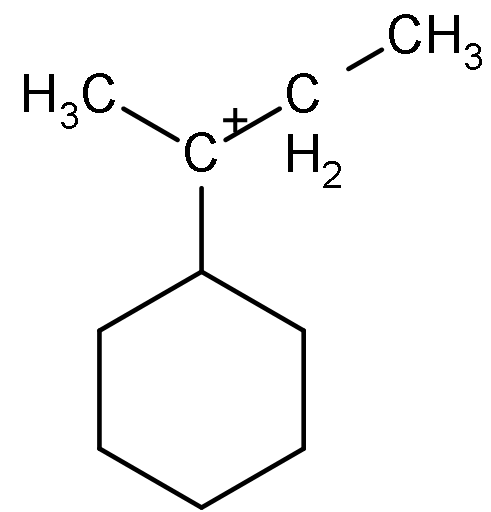
The total number of contributing structures showing hyperconjugation (involving $C - H$ bonds) for the following carbocation is:

(A) 4
(B) 5
(C) 6
(D) 7
Answer
217.8k+ views
Hint: For this problem, we have to count the total number of alpha hydrogens that are attached to the alpha carbons because the number of hyperconjugation structures is directly proportional to the number of alpha hydrogen present in the structure.
Complete step by step solution:
- In the given question, we have to explain the total number of contributing structures which will show hyperconjugation.
- Now, firstly we should know about the hyperconjugation as it is a process in which the delocalisation of the electron will take place.
- The delocalisation of the electron takes place between the sigma or single bond and pi bond or non-bonding lone pair.
- So, to calculate the total number of conjugating structures, the compound must have the alpha hydrogen.
- Now, alpha hydrogen is the hydrogen which is directly attached to the alpha carbon and alpha carbon is the carbon which is directly attached to the functional group or carbocation.
- Also, we know that the total number of hyperconjugation structures is directly proportional to the total number of alpha hydrogen atoms present in the structure.
- So, in the given compound as we can see that there is three alpha carbon that is attached to the carbocation directly.
- And out of the left alpha carbon has three alpha hydrogen, right alpha carbon has two alpha hydrogen and the alpha carbon that is present below the carbocation has one alpha carbocation.
- So, the total number of alpha-hydrogen will be $3 + 2 + 1 = 5$.
Therefore, option (B) is the correct answer.
Note: Hyperconjugation is different from that of the resonance because in hyperconjugation the delocalisation of the sigma and non-bonding electron takes place whereas in resonance the delocalisation of the pi electrons takes place only.
Complete step by step solution:
- In the given question, we have to explain the total number of contributing structures which will show hyperconjugation.
- Now, firstly we should know about the hyperconjugation as it is a process in which the delocalisation of the electron will take place.
- The delocalisation of the electron takes place between the sigma or single bond and pi bond or non-bonding lone pair.
- So, to calculate the total number of conjugating structures, the compound must have the alpha hydrogen.
- Now, alpha hydrogen is the hydrogen which is directly attached to the alpha carbon and alpha carbon is the carbon which is directly attached to the functional group or carbocation.
- Also, we know that the total number of hyperconjugation structures is directly proportional to the total number of alpha hydrogen atoms present in the structure.
- So, in the given compound as we can see that there is three alpha carbon that is attached to the carbocation directly.
- And out of the left alpha carbon has three alpha hydrogen, right alpha carbon has two alpha hydrogen and the alpha carbon that is present below the carbocation has one alpha carbocation.
- So, the total number of alpha-hydrogen will be $3 + 2 + 1 = 5$.
Therefore, option (B) is the correct answer.
Note: Hyperconjugation is different from that of the resonance because in hyperconjugation the delocalisation of the sigma and non-bonding electron takes place whereas in resonance the delocalisation of the pi electrons takes place only.
Recently Updated Pages
Arithmetic, Geometric & Harmonic Progressions Explained

Cartesian Form of Vector Explained: Formula, Examples & Uses

Apparent Frequency Explained: Formula, Uses & Examples

Calorimetry: Definition, Principles & Calculations

Centrifugal Force Explained: Definition, Formula & Examples

Charge in a Magnetic Field: Definition, Formula & Examples

Trending doubts
JEE Main 2026: Application Form Open, Exam Dates, Syllabus, Eligibility & Question Papers

Derivation of Equation of Trajectory Explained for Students

Hybridisation in Chemistry – Concept, Types & Applications

Understanding the Angle of Deviation in a Prism

Understanding Collisions: Types and Examples for Students

How to Convert a Galvanometer into an Ammeter or Voltmeter

Other Pages
NCERT Solutions For Class 12 Chemistry Chapter 1 Solutions - 2025-26

NCERT Solutions for Class 12 Chemistry Chapter Chapter 7 Alcohol Phenol and Ether

NCERT Solutions ForClass 12 Chemistry Chapter Chapter 8 Aldehydes Ketones And Carboxylic Acids

JEE Advanced Marks vs Ranks 2025: Understanding Category-wise Qualifying Marks and Previous Year Cut-offs

Haloalkanes and Haloarenes Class 12 Chemistry Chapter 6 CBSE Notes - 2025-26

Solutions Class 12 Chemistry Chapter 1 CBSE Notes - 2025-26




